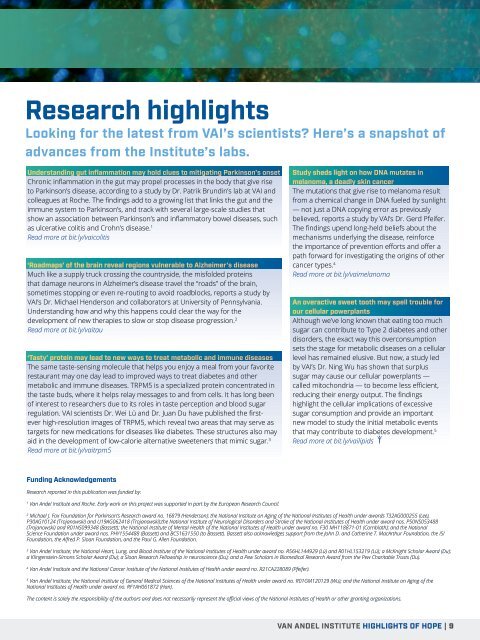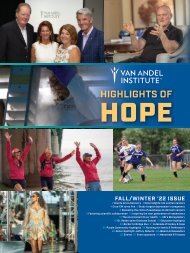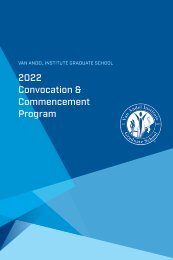2022 Spring/Summer Highlights of Hope
This is the 2022 Spring/Summer edition of Van Andel Institute's Highlights of Hope donor publication.
This is the 2022 Spring/Summer edition of Van Andel Institute's Highlights of Hope donor publication.
You also want an ePaper? Increase the reach of your titles
YUMPU automatically turns print PDFs into web optimized ePapers that Google loves.
Research highlights<br />
Looking for the latest from VAI’s scientists? Here’s a snapshot <strong>of</strong><br />
advances from the Institute’s labs.<br />
Understanding gut inflammation may hold clues to mitigating Parkinson’s onset<br />
Chronic inflammation in the gut may propel processes in the body that give rise<br />
to Parkinson’s disease, according to a study by Dr. Patrik Brundin’s lab at VAI and<br />
colleagues at Roche. The findings add to a growing list that links the gut and the<br />
immune system to Parkinson’s, and track with several large-scale studies that<br />
show an association between Parkinson’s and inflammatory bowel diseases, such<br />
as ulcerative colitis and Crohn’s disease. 1<br />
Read more at bit.ly/vaicolitis<br />
‘Roadmaps’ <strong>of</strong> the brain reveal regions vulnerable to Alzheimer’s disease<br />
Much like a supply truck crossing the countryside, the misfolded proteins<br />
that damage neurons in Alzheimer’s disease travel the “roads” <strong>of</strong> the brain,<br />
sometimes stopping or even re-routing to avoid roadblocks, reports a study by<br />
VAI’s Dr. Michael Henderson and collaborators at University <strong>of</strong> Pennsylvania.<br />
Understanding how and why this happens could clear the way for the<br />
development <strong>of</strong> new therapies to slow or stop disease progression. 2<br />
Read more at bit.ly/vaitau<br />
‘Tasty’ protein may lead to new ways to treat metabolic and immune diseases<br />
The same taste-sensing molecule that helps you enjoy a meal from your favorite<br />
restaurant may one day lead to improved ways to treat diabetes and other<br />
metabolic and immune diseases. TRPM5 is a specialized protein concentrated in<br />
the taste buds, where it helps relay messages to and from cells. It has long been<br />
<strong>of</strong> interest to researchers due to its roles in taste perception and blood sugar<br />
regulation. VAI scientists Dr. Wei Lü and Dr. Juan Du have published the firstever<br />
high-resolution images <strong>of</strong> TRPM5, which reveal two areas that may serve as<br />
targets for new medications for diseases like diabetes. These structures also may<br />
aid in the development <strong>of</strong> low-calorie alternative sweeteners that mimic sugar. 3<br />
Read more at bit.ly/vaitrpm5<br />
Study sheds light on how DNA mutates in<br />
melanoma, a deadly skin cancer<br />
The mutations that give rise to melanoma result<br />
from a chemical change in DNA fueled by sunlight<br />
— not just a DNA copying error as previously<br />
believed, reports a study by VAI’s Dr. Gerd Pfeifer.<br />
The findings upend long-held beliefs about the<br />
mechanisms underlying the disease, reinforce<br />
the importance <strong>of</strong> prevention efforts and <strong>of</strong>fer a<br />
path forward for investigating the origins <strong>of</strong> other<br />
cancer types. 4<br />
Read more at bit.ly/vaimelanoma<br />
An overactive sweet tooth may spell trouble for<br />
our cellular powerplants<br />
Although we’ve long known that eating too much<br />
sugar can contribute to Type 2 diabetes and other<br />
disorders, the exact way this overconsumption<br />
sets the stage for metabolic diseases on a cellular<br />
level has remained elusive. But now, a study led<br />
by VAI’s Dr. Ning Wu has shown that surplus<br />
sugar may cause our cellular powerplants —<br />
called mitochondria — to become less efficient,<br />
reducing their energy output. The findings<br />
highlight the cellular implications <strong>of</strong> excessive<br />
sugar consumption and provide an important<br />
new model to study the initial metabolic events<br />
that may contribute to diabetes development. 5<br />
Read more at bit.ly/vailipids<br />
Funding Acknowledgements<br />
Research reported in this publication was funded by:<br />
1<br />
Van Andel Institute and Roche. Early work on this project was supported in part by the European Research Council.<br />
2<br />
Michael J. Fox Foundation for Parkinson’s Research award no. 16879 (Henderson); the National Institute on Aging <strong>of</strong> the National Institutes <strong>of</strong> Health under awards T32AG000255 (Lee),<br />
P30AG10124 (Trojanowski) and U19AG062418 (Trojanowski);the National Institute <strong>of</strong> Neurological Disorders and Stroke <strong>of</strong> the National Institutes <strong>of</strong> Health under award nos. P50NS053488<br />
(Trojanowski) and R01NS099348 (Bassett); the National Institute <strong>of</strong> Mental Health <strong>of</strong> the National Institutes <strong>of</strong> Health under award no. F30 MH118871-01 (Cornblath); and the National<br />
Science Foundation under award nos. PHY1554488 (Bassett) and BCS1631550 (to Bassett). Bassett also acknowledges support from the John D. and Catherine T. MacArthur Foundation, the ISI<br />
Foundation, the Alfred P. Sloan Foundation, and the Paul G. Allen Foundation.<br />
3<br />
Van Andel Institute; the National Heart, Lung, and Blood Institute <strong>of</strong> the National Institutes <strong>of</strong> Health under award no. R56HL144929 (Lü) and R01HL153219 (Lü); a McKnight Scholar Award (Du);<br />
a Klingenstein-Simons Scholar Award (Du); a Sloan Research Fellowship in neuroscience (Du); and a Pew Scholars in Biomedical Research Award from the Pew Charitable Trusts (Du).<br />
4<br />
Van Andel Institute and the National Cancer Institute <strong>of</strong> the National Institutes <strong>of</strong> Health under award no. R21CA228089 (Pfeifer).<br />
5<br />
Van Andel Institute; the National Institute <strong>of</strong> General Medical Sciences <strong>of</strong> the National Institutes <strong>of</strong> Health under award no. R01GM120129 (Wu); and the National Institute on Aging <strong>of</strong> the<br />
National Institutes <strong>of</strong> Health under award no. RF1AH061872 (Han).<br />
The content is solely the responsibility <strong>of</strong> the authors and does not necessarily represent the <strong>of</strong>ficial views <strong>of</strong> the National Institutes <strong>of</strong> Health or other granting organizations.<br />
VAN ANDEL INSTITUTE HIGHLIGHTS OF HOPE | 9
















